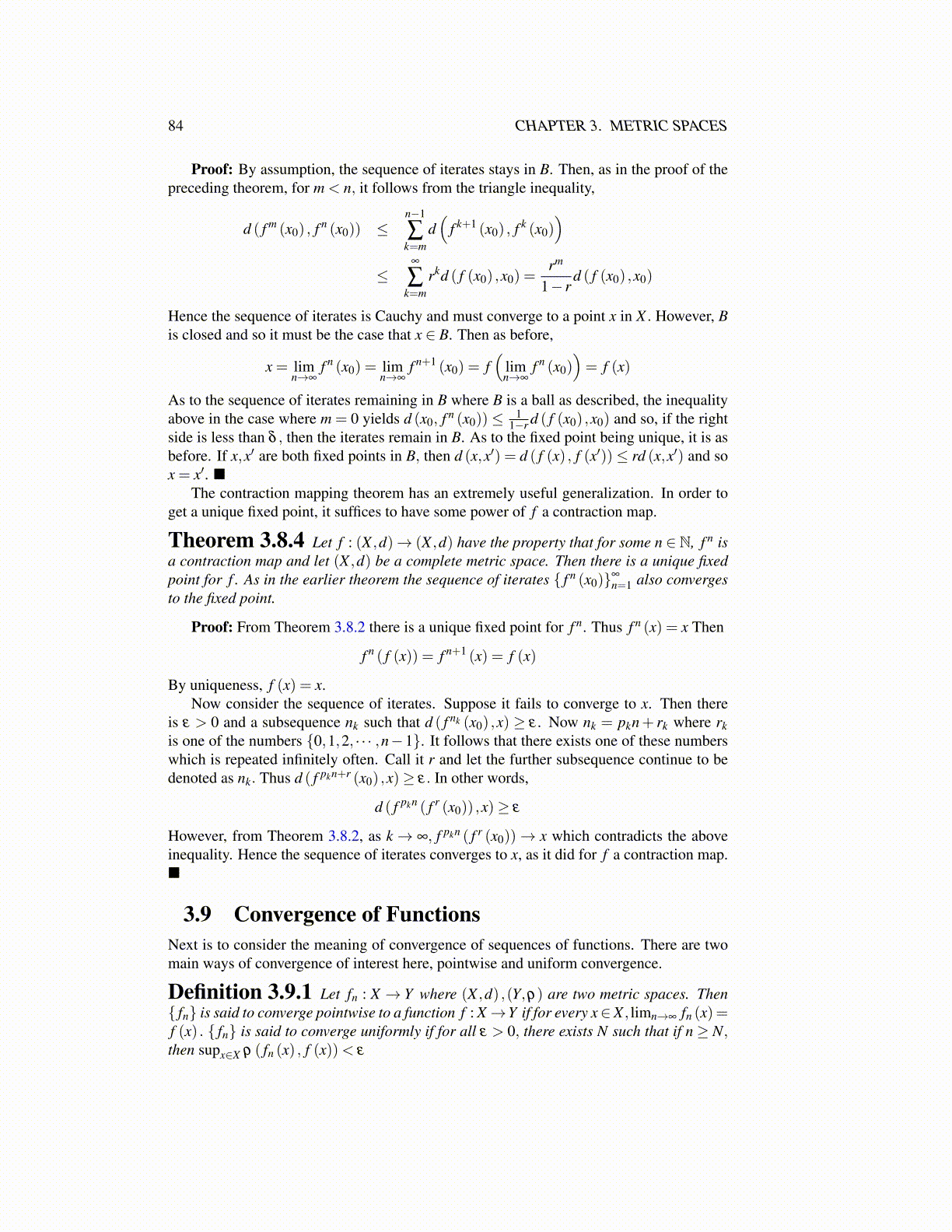
84 CHAPTER 3. METRIC SPACES
Proof: By assumption, the sequence of iterates stays in B. Then, as in the proof of thepreceding theorem, for m < n, it follows from the triangle inequality,
d ( f m (x0) , f n (x0)) ≤n−1
∑k=m
d(
f k+1 (x0) , f k (x0))
≤∞
∑k=m
rkd ( f (x0) ,x0) =rm
1− rd ( f (x0) ,x0)
Hence the sequence of iterates is Cauchy and must converge to a point x in X . However, Bis closed and so it must be the case that x ∈ B. Then as before,
x = limn→∞
f n (x0) = limn→∞
f n+1 (x0) = f(
limn→∞
f n (x0))= f (x)
As to the sequence of iterates remaining in B where B is a ball as described, the inequalityabove in the case where m = 0 yields d (x0, f n (x0))≤ 1
1−r d ( f (x0) ,x0) and so, if the rightside is less than δ , then the iterates remain in B. As to the fixed point being unique, it is asbefore. If x,x′ are both fixed points in B, then d (x,x′) = d ( f (x) , f (x′))≤ rd (x,x′) and sox = x′. ■
The contraction mapping theorem has an extremely useful generalization. In order toget a unique fixed point, it suffices to have some power of f a contraction map.
Theorem 3.8.4 Let f : (X ,d)→ (X ,d) have the property that for some n ∈ N, f n isa contraction map and let (X ,d) be a complete metric space. Then there is a unique fixedpoint for f . As in the earlier theorem the sequence of iterates { f n (x0)}∞
n=1 also convergesto the fixed point.
Proof: From Theorem 3.8.2 there is a unique fixed point for f n. Thus f n (x) = x Then
f n ( f (x)) = f n+1 (x) = f (x)
By uniqueness, f (x) = x.Now consider the sequence of iterates. Suppose it fails to converge to x. Then there
is ε > 0 and a subsequence nk such that d ( f nk (x0) ,x) ≥ ε . Now nk = pkn+ rk where rkis one of the numbers {0,1,2, · · · ,n−1}. It follows that there exists one of these numberswhich is repeated infinitely often. Call it r and let the further subsequence continue to bedenoted as nk. Thus d ( f pkn+r (x0) ,x)≥ ε. In other words,
d ( f pkn ( f r (x0)) ,x)≥ ε
However, from Theorem 3.8.2, as k→ ∞, f pkn ( f r (x0))→ x which contradicts the aboveinequality. Hence the sequence of iterates converges to x, as it did for f a contraction map.■
3.9 Convergence of FunctionsNext is to consider the meaning of convergence of sequences of functions. There are twomain ways of convergence of interest here, pointwise and uniform convergence.
Definition 3.9.1 Let fn : X → Y where (X ,d) ,(Y,ρ) are two metric spaces. Then{ fn} is said to converge pointwise to a function f : X→Y if for every x∈X , limn→∞ fn (x)=f (x) . { fn} is said to converge uniformly if for all ε > 0, there exists N such that if n≥ N,then supx∈X ρ ( fn (x) , f (x))< ε